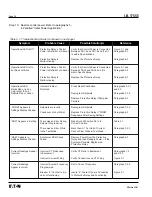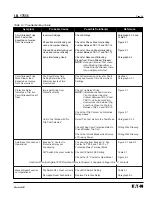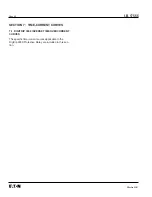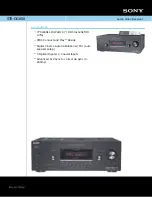
I.B. 17555
Page 25
Effective 03/97
ing that the Program Mode has been entered. The pre-
sent value of the first setpoint to be programmed (Curve
Shape) will appear in the Settings/Test Time/Trip Cause
Window, which will be referred to as the Alpha-numeric
Display for the rest of this discussion. The Curve Shape
LED will be blinking green. The Raise or Lower pushbut-
tons can now be used to change the value of the set-
point. Keep in mind that the Raise and Lower pushbut-
tons will roll over from highest to lowest and lowest to
highest respectively. If either of the pushbuttons is held
down and not released, their function is accelerated.
This is true for all white pushbuttons on the panel face.
The curve shape setting is selectable for both the phase
and ground curves. Refer to Section 2-1.4 and Table 2.1
to review the curve shape selection possibilities.
Pressing and releasing the Select Settings pushbutton
will cause the unit to step to the next setpoint. This is
the Phase Inverse Time Overcurrent Pickup setting. The
Inverse Time Overcurrent Pickup LED will blink green.
Simultaneously, the Phase LED will be blinking green,
indicating that this setting is associated with the phase
protection curve.
After the Raise and/or Lower pushbuttons are used to
arrive at the desired Phase Inverse Time Overcurrent
Pickup, the Select Settings pushbutton can be pressed
and released to step to the next setpoint, which is the
Phase Time Multiplier. The Time Multiplier setting LED
will blink green along with the Phase LED. Refer to
Table 2.2 for the available settings and note that the
available settings can vary, depending upon which
curve shape was previously selected.
Pressing and releasing the Select Settings pushbutton
will cause the unit to step to the Phase Short Delay
Pickup setting. Refer to Table 2.2 for the available set-
tings. This function can be disabled by selecting the
“NONE” setting. The Short Delay Pickup LED and the
Phase LED will blink green. After the Raise and/or
Lower pushbuttons are used to arrive at the desired set-
ting, the Select Settings pushbutton is pressed and
released to move to the next setpoint. The next setpoint
is Short Delay Time setting (Table 2.2), unless “NONE”
was selected for the Short Delay Pickup. If “NONE” was
selected, the Short Delay Time setting will automatically
be bypassed in favor of the next in order setting, Phase
Instantaneous Pickup.
When at the Phase Instantaneous Pickup setting, both
the Instantaneous Pickup LED and the Phase LED will
blink green. Refer to Table 2.2 for the available instanta-
neous settings. Once a selection other than “NONE” is
made and the Select Settings pushbutton is pressed and
released, the unit steps to the next setpoint. If “NONE” is
the setting selected and the Select Settings pushbutton
is pressed and released, the Phase and Instantaneous
LEDs remain on and the unit will now offer a choice of
whether to turn the discriminator option on or off. Refer
to Section 2-1.4 to review the discriminator option
details. Once the discriminator option selection is made
and the Select Settings pushbutton is pressed and
released, the unit steps to the next setpoint.
Ground Inverse Time Overcurrent setting is the next set-
point. The Ground Curve Shape LED and the Ground
LED will blink green. Use the Raise and/or Lower push-
buttons to arrive at the desired Ground Curve Shape
Setting.
Programming the ground setpoints is handled in the
same manner as was used in selecting the phase set-
points, except for the following:
1. The Ground Inverse Time Overcurrent Pickup can be
disabled by selecting “NONE.” This is not possible on
the Phase Inverse Time Overcurrent Pickup.
2. If “NONE” is selected for the Ground Instantaneous
Pickup setting, there is no discriminator option, as
was the case for Phase Instantaneous Pickup setting.
For a complete listing of all the available ground set-
points, refer to Table 2.3.
When all of the ground setpoints are established and
the Select Settings pushbutton is pressed and released,
the unit steps to the High Load Setting. The High Load
LED will blink green and the last programmed value for
the High Load time setting will appear in the alphanu-
meric display. Refer to Section 2-1.4 and Table 2.3 to
review the High Load function and/or to select the
appropriate High Load time setting. Once this selection
is made and the Select Settings pushbutton is pressed
and released, the unit steps to the next setpoint.
The next setpoint selection to be made is the
Frequency. The choices are 60Hz and 50Hz. When this
selection is made and the Select Settings pushbutton is
pressed and released, the relay steps to the Phase CT
Ratio Setting.
The Phase LED will blink green and the programmed
value for the phase CT will appear in the alphanumeric
display. Refer to Table 2.4 to select the desired CT
ratio. Once this selection is made and programmed, the
Select Settings pushbutton is pressed and released to
move to the last setpoint.
The last setpoint selection to be made is the Ground CT
Ratio Setting. Refer to Table 2.4 to select the desired
















































